Qatar may be a small country in the Middle East, but don’t let its size fool you!
Spanning just about 11,610 square kilometers, this vibrant nation is packed with opportunities.
Nestled beside Saudi Arabia and surrounded by the stunning Persian Gulf on three sides, Qatar has become a hub for professionals worldwide.
From thriving industries like petroleum and energy to booming sectors such as science, technology, hospitality, and construction, the country continues to attract people from all over.
And let’s not forget the high standard of living—it’s no wonder so many expats choose to call Qatar home!
With such a diverse and ever-growing population, Qatar’s demographics have transformed significantly over the years.
But what does that look like in 2025?
In this article, we’ll dive into Qatar’s latest population statistics.
We’ll uncover the total population, the mix of expatriates and locals, gender distribution, and how the country’s population has grown over the past decade.
Let’s explore!
Key Population Statistics of Qatar 2025
The population of Qatar stands at 3.12 million.
The population density in Qatar is 234 persons per square km.
The median age is 33.8 years.
The male population is 2.4 million and the female population is 0.72 million.
The population of the age group 25-54 is the highest, consisting of 2.18 million.
The non-Qatari population is 2.76 million while the Qatari population is 0.36 million.
Muslims form the majority group in Qatar with 2.034 million people.
Doha is the most populated city in Qatar with 47.65% of the population residing there.
Qatar Population Statistics 2025 [Infographics]

Qatar’s Population: Different Sources, Different Numbers – What’s the Real Count?
Qatar Government Website | 3.12 Million |
Statista | 2.90 Million |
Worldometers.info | 2.73 Million |
Worldpopulationreview.com | 2.73 Million |
Populationpyramid.net | 2.73 Million |
The world Factbook | 2.53 Million |
When it comes to Qatar’s total population in 2025, the numbers can vary depending on where you look.
Different sources report slightly different figures, making it a bit of a numbers game!
According to Qatar’s official website, the population stands at 3.12 million.
But if you check Statista, it’s listed as 2.90 million.
Meanwhile, sources like Worldometers.info, Worldpopulationreview.com, and Populationpyramid.net estimate it at 2.73 million.
And then there’s The World Factbook, which provides an even lower figure of 2.53 million.
So, who’s got it right?
Well, population estimates often vary based on data collection methods, time of reporting, and whether temporary residents or expatriates are included.
But one thing’s for sure—Qatar’s population is growing, and it’s an interesting trend to watch!
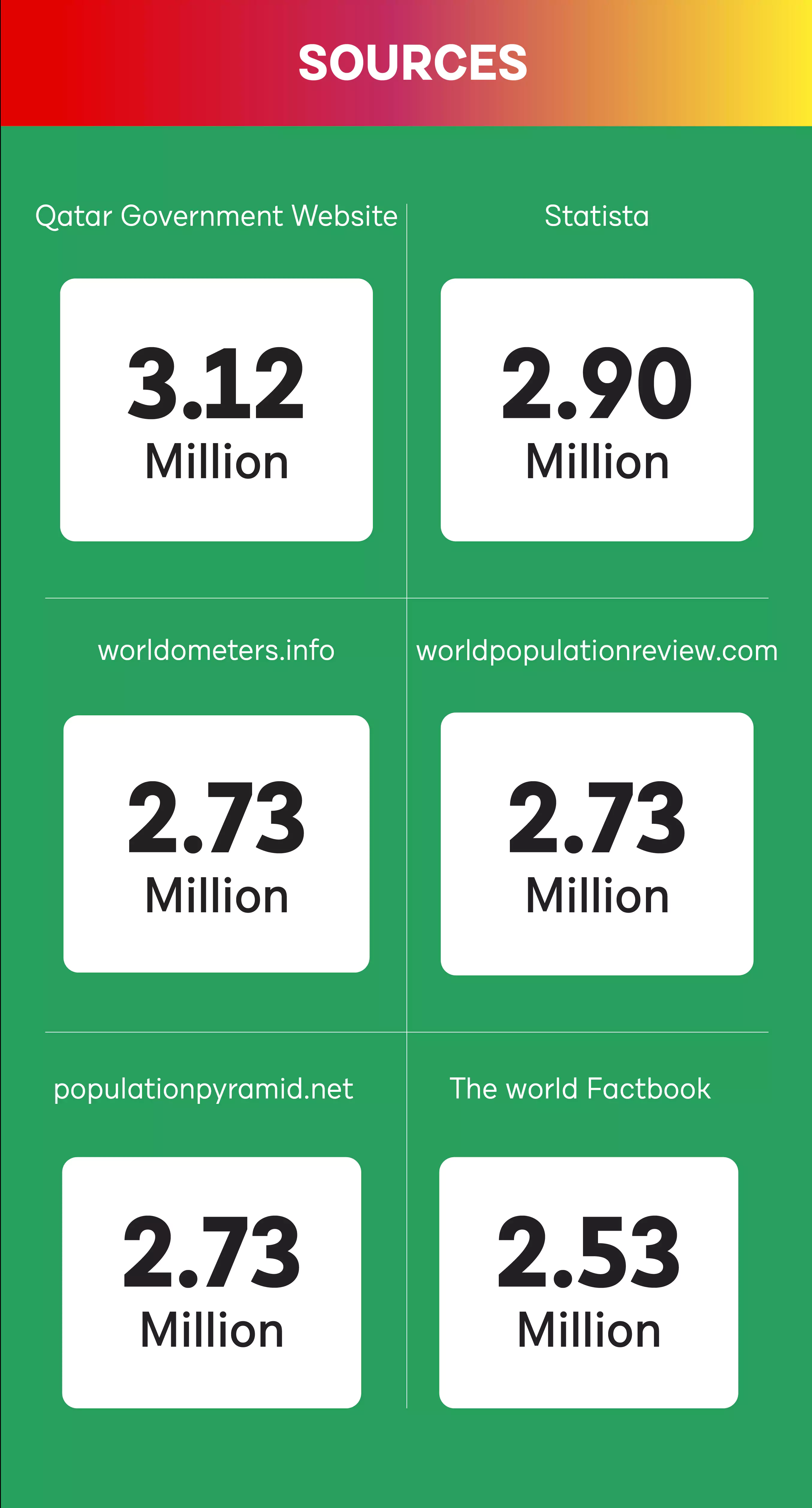
General Information
Population Density | 234 per Km2 |
Median Age | 33.8 Years |
Total Land Area | 11,610 Km2 |
Capital City | Doha |
Official Language | Arabic |
Qatar is a fascinating little peninsula, almost entirely surrounded by water, with a landscape that’s mostly flat desert sprinkled with loose sand and gravel.
But here’s a fun surprise—not all of Qatar is dry and barren! Some areas near the eastern coast actually have patches of greenery, with trees and shrubs adding a touch of nature to the scenery.
Head west, and you’ll find rocky hills known as ‘jebels,’ adding a bit of elevation to the otherwise flat terrain.
And let’s not forget the stunning coastline—stretching around 700 kilometers, it’s home to beautiful beaches and crystal-clear waters.
As for daily life, Arabic is the official language, and everything revolves around the bustling capital, Doha.
Qatar’s population density sits at 234 people per square kilometer, and with a median age of 33.8 years, it’s a relatively young and vibrant nation.
Qatar might be small, but it’s packed with unique landscapes, culture, and a thriving community!
Demographics of Qatar in 2025
As we dug into Qatar’s demographics for 2025, we discovered some fascinating insights that truly highlight the country’s unique population dynamics.
From the mix of locals and expatriates to gender distribution and population trends, there’s a lot to unpack!
So, let’s dive in and explore what makes Qatar’s population so interesting.
Qatar’s Population: The Gender Split 👥
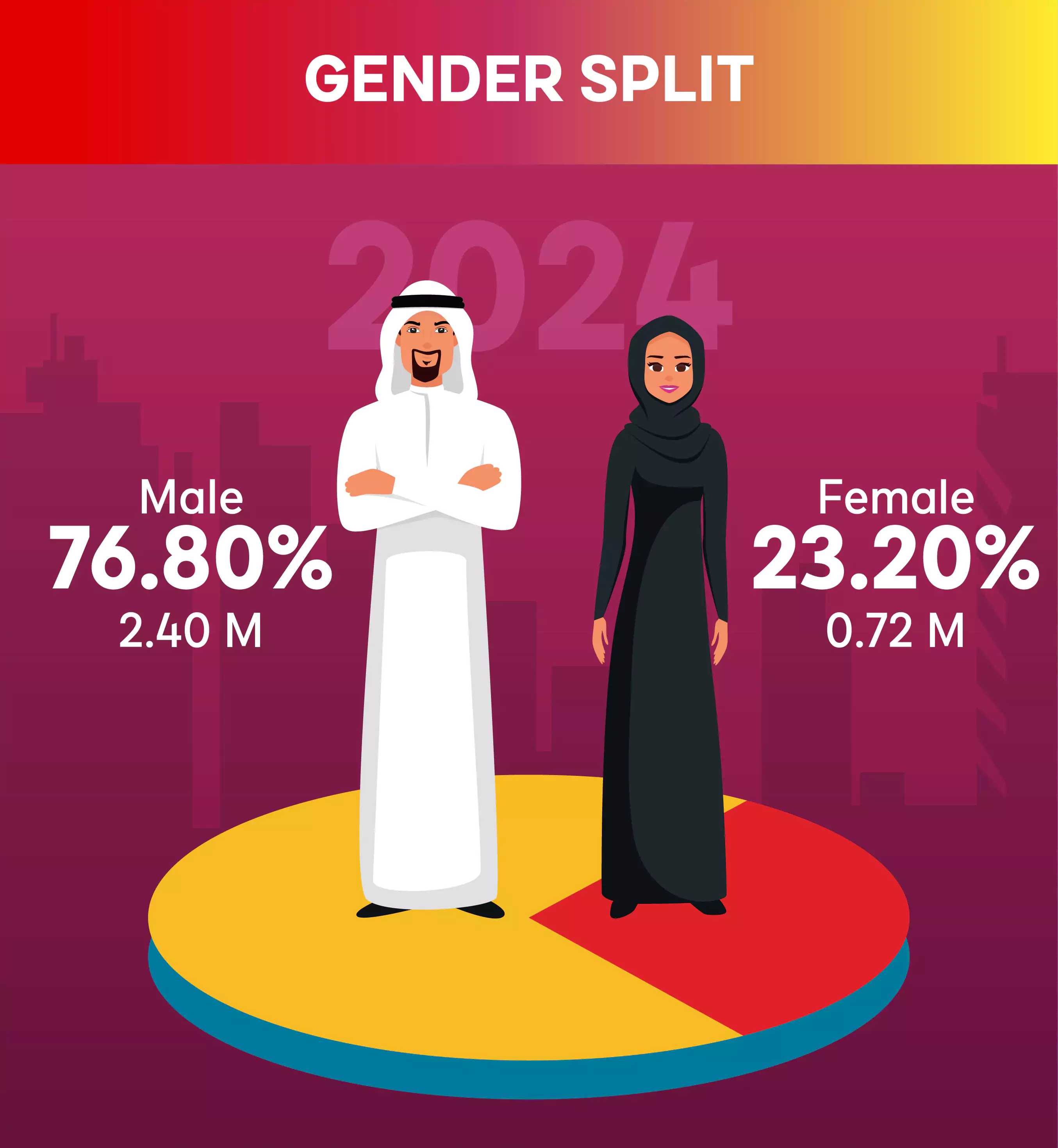
Qatar’s population has a pretty unique gender ratio!
Men make up a whopping 76.8% of the total population, which translates to around 2.4 million people.
Meanwhile, women account for just 23.2%, with a population of 0.72 million.
Why the big gap?
It’s mainly due to the large number of expatriate workers, especially in industries like construction, oil, and gas, where the workforce is predominantly male.
This gender imbalance has been a consistent trend in Qatar, shaping the country’s demographics in interesting ways.
Pretty fascinating, right?
Gender | Percentage | Population |
Male | 76.80% | 2.40 Million |
Female | 23.20% | 0.72 Million |
Qatar’s Population by Age – A Look at the Numbers 📊
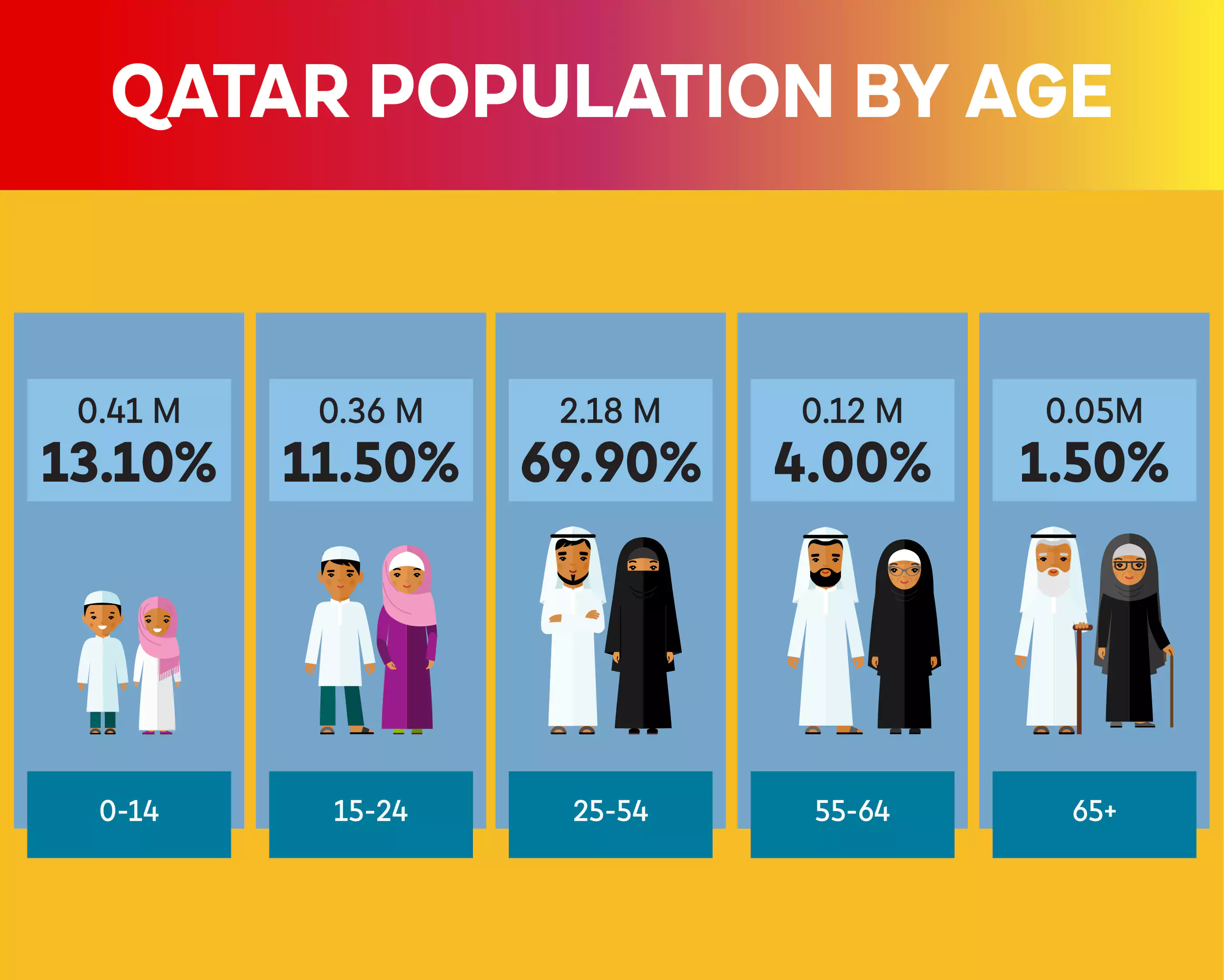
Qatar’s population is largely made up of young and working-age people, making it a dynamic and energetic country!
Here’s how the numbers break down:
👶 Kids & Teens (0-14 years): They make up 13.1% of the population, totaling 0.41 million. The future generation of Qatar!
🎓 Young Adults (15-24 years): Around 11.5%, or 0.36 million, fall into this age group—students, fresh graduates, and young professionals stepping into the workforce.
💼 Prime Working Age (25-54 years): This is the largest group, making up a massive 69.9% of the population (2.18 million). These are the professionals, business owners, and workers driving Qatar’s economy.
🧑🦳 Pre-Retirement (55-64 years): A smaller 4%, or 0.12 million, are in this category, likely wrapping up their careers or transitioning to retirement.
🏡 Seniors (65+ years): The smallest group, just 1.5% (0.05 million), reflecting Qatar’s younger demographic makeup.
With such a young and active population, Qatar continues to be a hub of innovation, growth, and opportunity!
Age Group | Percentage | Population |
0-14 years | 13.10% | 0.41 Million |
15-24 years | 11.50% | 0.36 Million |
25-54 years | 69.90% | 2.18 Million |
55-64 years | 4.00% | 0.12 Million |
65 years and over | 1.50% | 0.05 Million |
Qatar Population By Gender
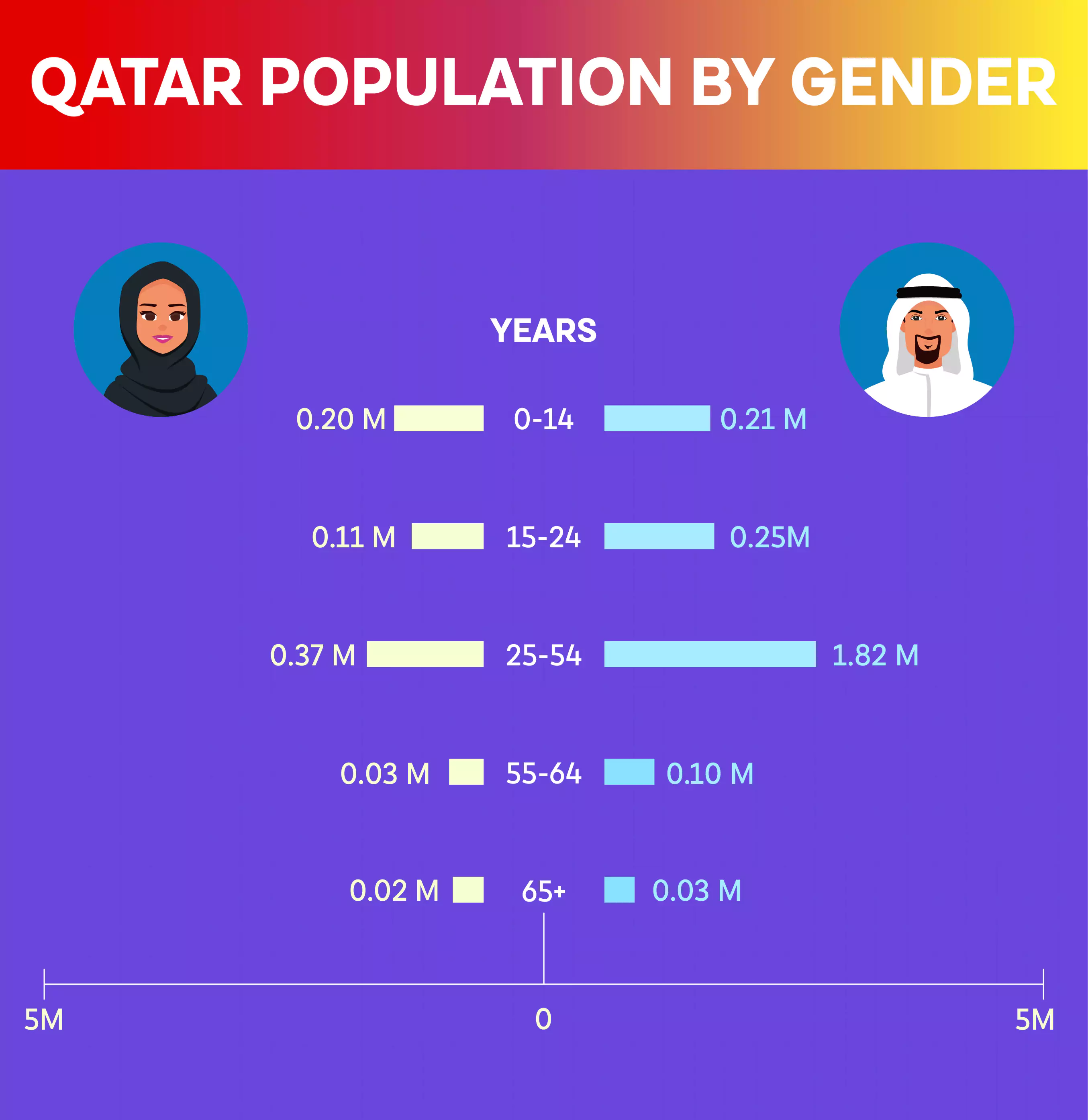
Qatar’s population has a unique gender distribution across different age groups, and the numbers tell an interesting story!
👶 Children (0-14 years): The gender split here is almost even, with 0.21 million boys and 0.20 million girls growing up in Qatar. A balanced start!
🎓 Young Adults (15-24 years): Here’s where the gap starts to widen—0.25 million men compared to 0.11 million women. This age group includes students and early-career professionals.
💼 Working Age (25-54 years): This is where we see the biggest difference—1.82 million men versus just 0.37 million women. The large number of male expatriate workers in industries like construction, oil, and gas plays a major role in this imbalance.
🧑🦳 Pre-Retirement (55-64 years): The numbers shrink here, with 0.10 million men and 0.03 million women, reflecting the aging workforce.
🏡 Seniors (65+ years): A small but significant group, with 0.03 million men and 0.02 million women, showing that Qatar has a relatively young population overall.
With a workforce-driven demographic and a strong expatriate presence, Qatar’s gender and age distribution make for a fascinating population landscape! 🚀
Age Group | Men Population | Women Population |
0-14 years | 0.21 Million | 0.20 Million |
15-24 years | 0.25 Million | 0.11 Million |
25-54 years | 1.82 Million | 0.37 Million |
55-64 years | 0.10 Million | 0.03 Million |
65 years and over | 0.03 Million | 0.02 Million |
Qatari V/S Expatriates
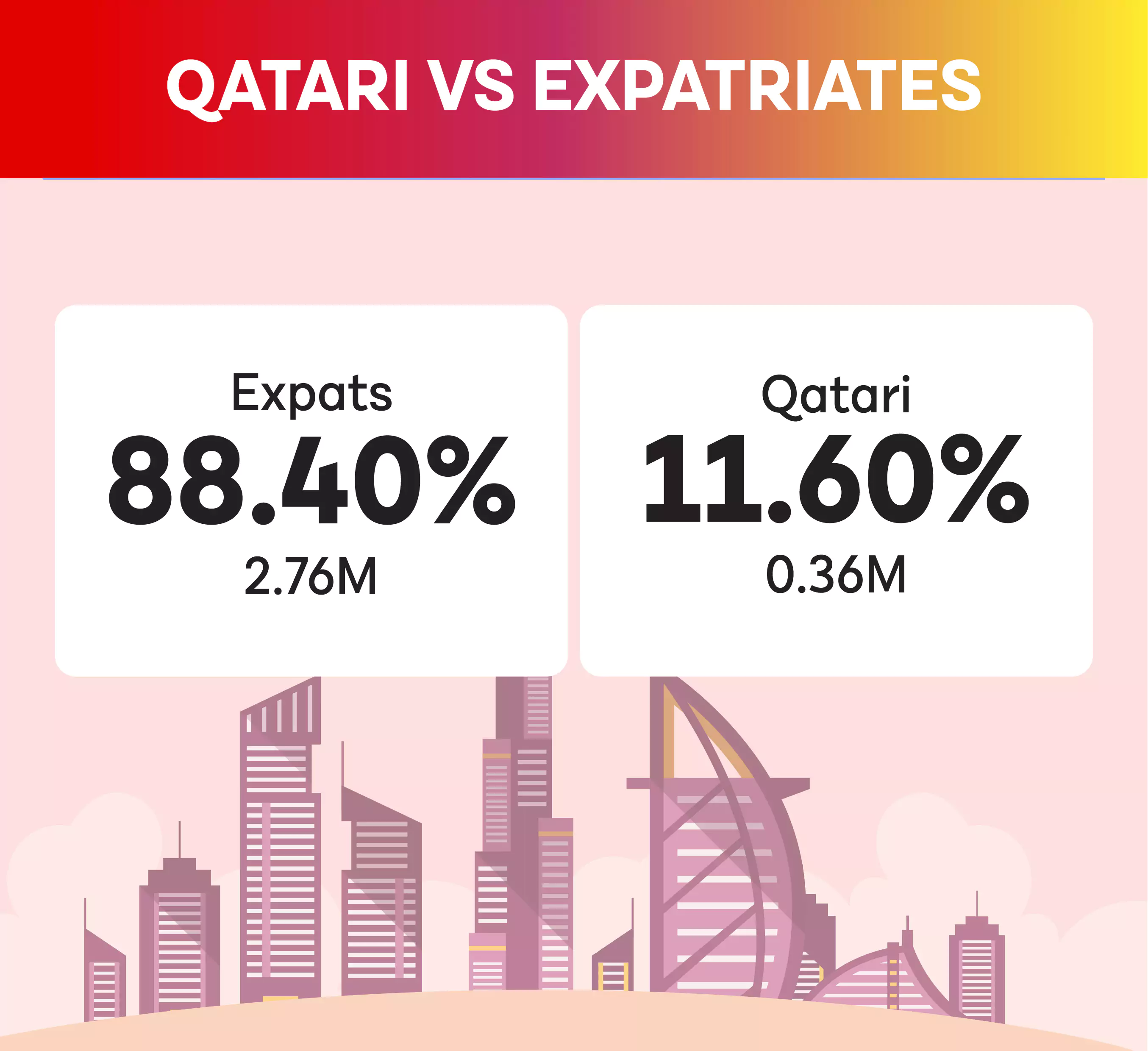
Similar to other Gulf countries, Qatar’s population is characterized by a diverse mix of expatriate communities.
According to the 2025 population report, expatriates constitute the majority, making up approximately 88.4% of the population, equivalent to around 2.76 million people.
In contrast, Qatari nationals represent a smaller proportion, accounting for approximately 11.6% of the population, or about 0.36 million people.
Qatar is actively pursuing its Qatarization initiative, aiming to increase the employment of Qatari citizens in both public and private sectors.
The target is to achieve 50% representation of Qatari citizens in the core sectors.
These efforts align with the Qatar National Vision 2030, and all of this will result in maintaining a more balanced population.
Nationality | Population | Percentage |
Qatari | 0.36 Million | 11.60% |
Expats | 2.76 Million | 88.40% |
Qatar Population By Nationality
Qatar is home to a truly international mix of people, with expatriates making up the vast majority of its population.
Here’s a closer look at where most residents come from:
🇮🇳 India tops the list with 700,000 people, making up 21.8% of Qatar’s population!
🇧🇩 Bangladesh and 🇳🇵 Nepal follow closely, each with 400,000 residents (about 12.5%).
🇶🇦 Qatari nationals account for 10.5% of the population, with 330,000 people.
🇪🇬 Egyptians make up 9.35%, contributing 300,000 residents.
🇵🇭 Filipinos form 7.36% of the population, with 236,000 people calling Qatar home.
🇵🇰 Pakistanis, 🇱🇰 Sri Lankans, and 🇸🇩 Sudanese also have significant communities.
🌍 Other nationalities, including Syrians, Jordanians, Lebanese, Americans, Kenyans, and Iranians, make up smaller but vital portions of the population.
With such a diverse mix of cultures, languages, and traditions, Qatar is more than just a country—it’s a global hub where people from all over the world come to live, work, and thrive!
Country | Population | Percentage |
India | 700000 | 21.80% |
Bangladesh | 400000 | 12.50% |
Nepal | 400000 | 12.50% |
Qatar | 330000 | 10.50% |
Egypt | 300000 | 9.35% |
Philippines | 236000 | 7.36% |
Pakistan | 180000 | 4.70% |
Sri Lanka | 140000 | 4.35% |
Sudan | 60000 | 1.90% |
Syria | 54000 | 1.80% |
Jordan | 51000 | 1.60% |
Lebanon | 40000 | 1.25% |
United States | 40000 | 1.25% |
Kenya | 30000 | 1.00% |
Iran | 30000 | 1.00% |
Qatar Population By Year
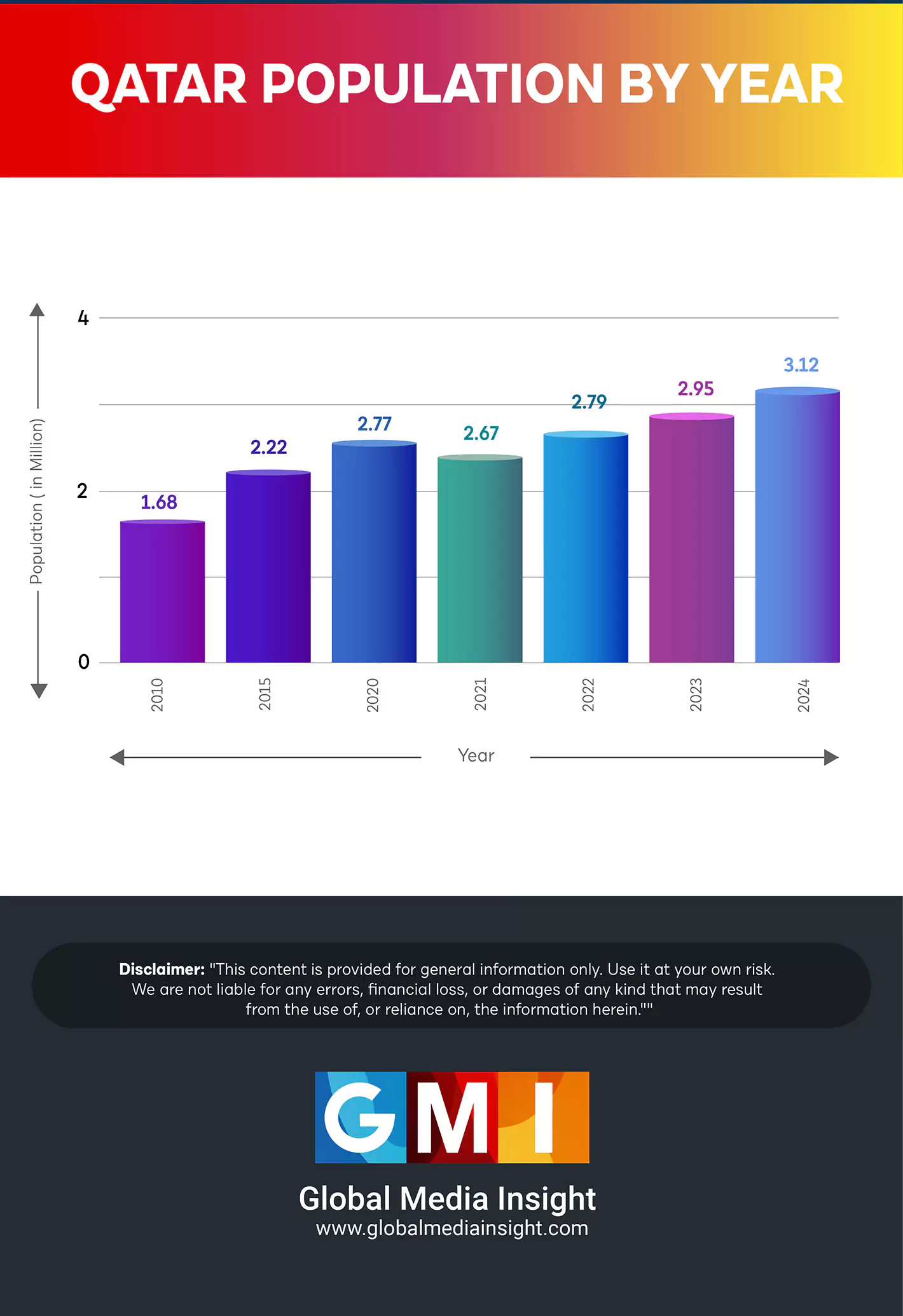
Qatar’s population has seen remarkable growth over the years, and the numbers tell an interesting story.
Just take a look:
Year | Population |
2025 | 3.12 Million |
2024 | 3.00 Million |
2023 | 2.95 Million |
2022 | 2.79 Million |
2021 | 2.67 Million |
2020 | 2.77 Million |
2015 | 2.22 Million |
2010 | 1.68 Million |
In just 15 years, Qatar’s population has nearly doubled!
From 1.68 million in 2010 to over 3.12 million in 2025, this rapid rise is a reflection of the country’s booming economy, world-class infrastructure, and growing opportunities.
Whether it’s the influx of skilled professionals, entrepreneurs, or investors, Qatar continues to attract people from all over the world.
And with ongoing developments, this upward trend might just continue!
Qatar Population By Religion
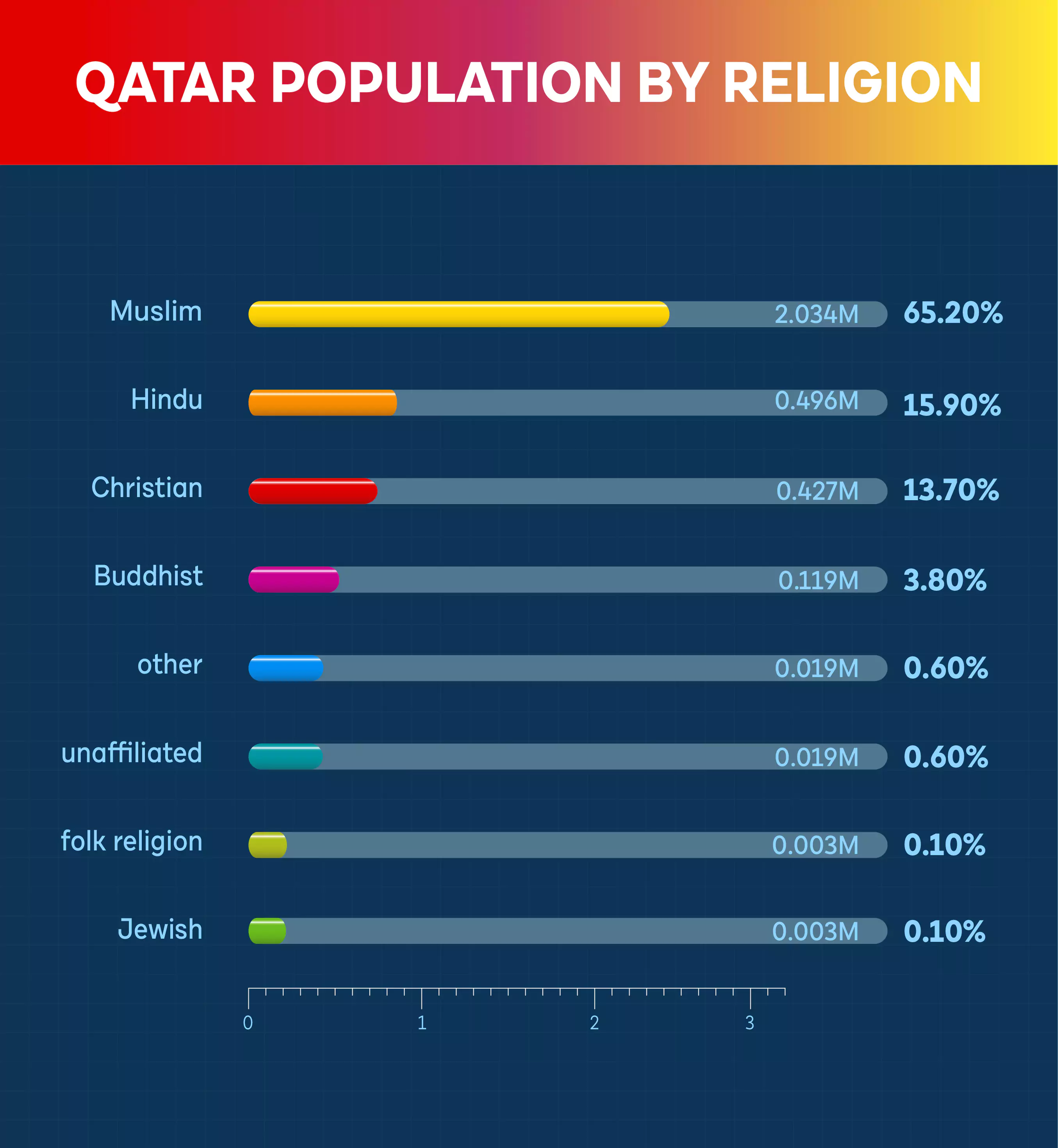
Qatar’s religious landscape is as diverse as its population, reflecting the rich mix of cultures and communities living in the country.
Here’s a closer look at the numbers:
Religion | Percentage | Population |
Muslim | 65.20% | 2.034 Million |
Hindu | 15.90% | 0.496 Million |
Christian | 13.70% | 0.427 Million |
Buddhist | 3.80% | 0.119 Million |
Other | 0.60% | 0.019 Million |
Unaffiliated | 0.60% | 0.019 Million |
Folk Religion | 0.10% | 0.003 Million |
Jewish | 0.10% | 0.003 Million |
As expected, Islam is the predominant religion in Qatar, with over 65% of the population identifying as Muslim.
However, the country is also home to significant Hindu (15.9%) and Christian (13.7%) communities, primarily driven by expatriates from South Asia and other parts of the world.
Buddhists, along with smaller groups practicing folk religions and other faiths, add to the cultural diversity.
Interestingly, around 0.6% of the population identifies as unaffiliated, choosing not to associate with any religion.
This blend of religious backgrounds contributes to Qatar’s vibrant and multicultural society, making it a unique place where different beliefs and traditions coexist!
Qatar Population By City
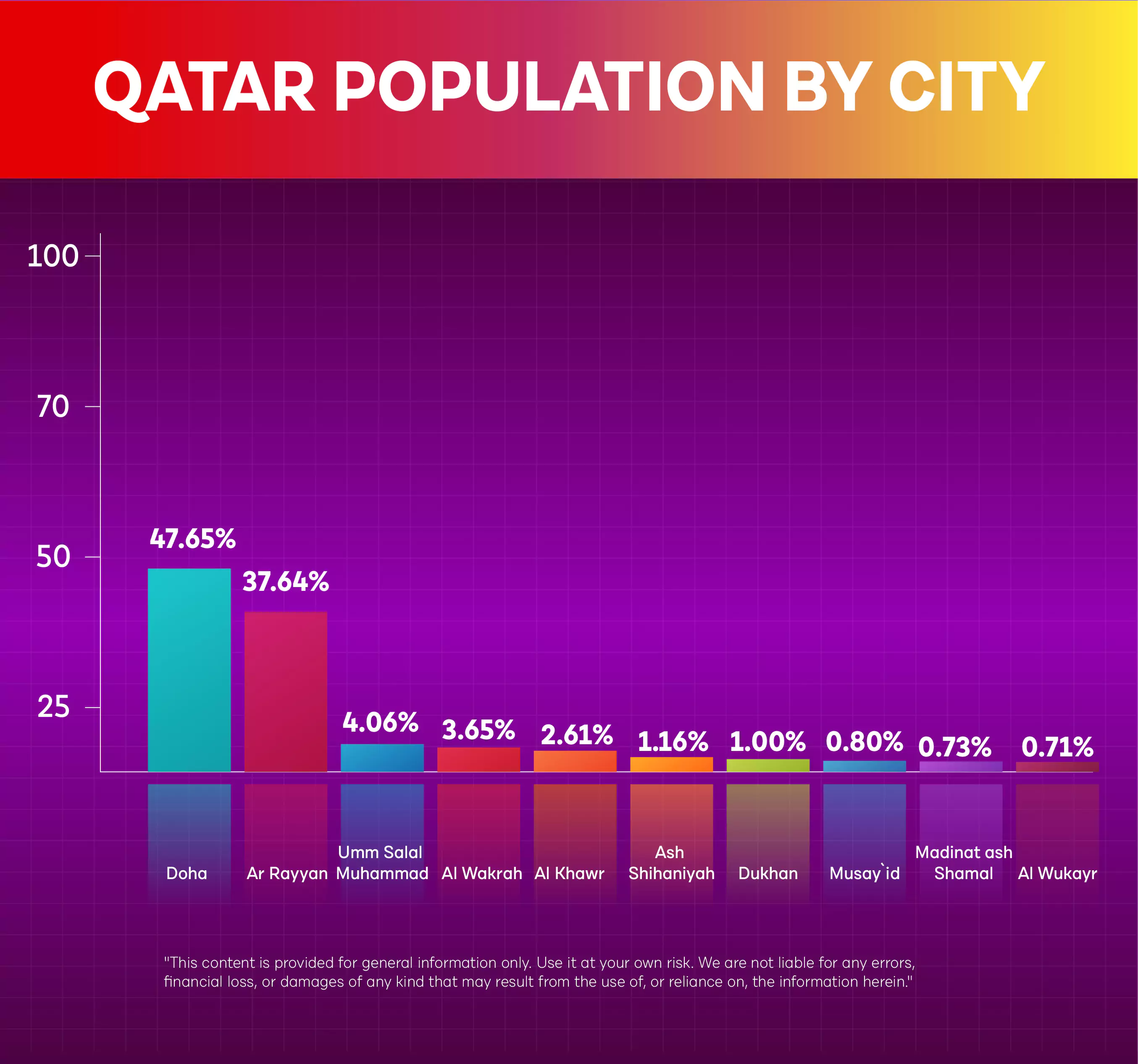
Qatar’s population is largely concentrated in a few key cities, with Doha leading the way as the country’s bustling capital.
Let’s break it down:
City | Percentage |
Doha | 47.65% |
Ar Rayyan | 37.64% |
Umm Salal Muhammad | 4.06% |
Al Wakrah | 3.65% |
Al Khawr | 2.61% |
Ash Shihaniyah | 1.16% |
Dukhan | 1.00% |
Musay`id | 0.80% |
Madinat ash Shamal | 0.73% |
Al Wukayr | 0.71% |
It’s no surprise that Doha, Qatar’s economic and cultural hub, is home to nearly half the country’s population.
With its modern skyline, thriving business districts, and vibrant lifestyle, it’s the heart of the nation.
Not far behind is Ar Rayyan, making up 37.64% of the population.
This city is known for its mix of residential neighborhoods and sporting facilities, including the iconic Education City and Khalifa International Stadium.
Meanwhile, Umm Salal Muhammad, Al Wakrah, and Al Khawr each have smaller yet significant communities, playing key roles in Qatar’s infrastructure and development.
From the industrial zone of Musay`id to the quiet coastal town of Madinat ash Shamal, Qatar’s cities offer a fascinating mix of urban dynamism and serene escapes, making it a truly unique country to live in!
Conclusion
With a population of over 3 million, Qatar stands as a vibrant melting pot of nationalities, with expatriates playing a pivotal role in its development.
As the Qatar government takes steps to reduce these disparities and move ahead in its developmental journey, the dynamics of its population will undoubtedly remain a central focus, driving social, economic, and cultural transformation in the years to come.
⚠️ Disclaimer & Note: This content is for general informational purposes only. We are not responsible for any errors, financial loss, or damages that may result from its use or reliance. Please verify the information with official sources as needed. Also, please note that population figures may vary slightly as they are updated from multiple sources.

GMI’s Research Team is a panel of knowledgeable experts from various fields such as digital marketing, social media, and web development, all united by a common goal—to educate. We enjoy exploring everything from the latest industry trends and emerging technologies to people and demographics, both in the UAE and beyond. Through our blog posts, we share valuable insights that help businesses and marketers stay informed and prepared for the challenges and opportunities that lie ahead.









